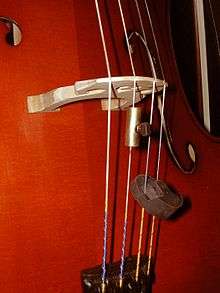Wolf tone
A wolf tone, or simply a "wolf",[1] is a sustaining sympathetic artificial overtone that amplifies and expands the frequencies of a played musical note, and is produced when the original note matches the natural resonant frequency of the body of the musical instrument. A wolf tone is frequently accompanied by an oscillating beating (due to the uneven frequencies between the natural note and artificial overtone), which may be likened to the howling of a wolf. A similar phenomenon is the beating produced by a wolf interval, which is usually the interval between E♭ and G♯ of the various non-circulating temperaments.
Stringed instruments

Wolf tones are usually only noticed on bowed instruments, most notably the violin family, since the tones produced are played for much longer periods, and thus are easier to hear. Frequently, the wolf is present on or in between the pitches E and F♯ on the cello, and around G♯ on the double bass.[2][3] A wolf can be reduced or eliminated with a piece of equipment called a wolf tone eliminator. This is a metal tube and mounting screw with an interior rubber sleeve, that fits around the offending string below the bridge. Different placements of this tube along the string influence or eliminate the frequency at which the wolf occurs. It is essentially an attenuator that slightly shifts the natural frequency of the string (and/or instrument body) cutting down on the reverberation.[1]
An older device on cellos was a fifth string that could be tuned to the wolf frequency; fingering an octave above or below also attenuates the effect somewhat, as does the trick of squeezing with the knees.[4][5]
While it has been said that Lou Harrison wrote a piece (evidently reworked as the second movement of the Suite for Cello and Harp) that exploited the wolf specific to Seymour Barab's new cello, there is no clear evidence that this occurred.
"Naldjorlak I", composed by Éliane Radigue for realisation exclusively by the cellist Charles Curtis is in fact composed solely around the manipulation of the wolf tone of Curtis's cello.
See also
References
- Freiberg, Sarah (2005-05-12). "How to Tame Annoying Howling Wolf Tones". Strings Magazine. Retrieved 2019-01-21.
- Dünnwald, H. (1979). "Versuche zur Entstehung des Wolfs bei Violininstrumenten". Acustica. 41 (4): 238–45.
- Firth, Ian M. (1973). "The wolf in the cello". The Journal of the Acoustical Society of America. 53 (2): 457. doi:10.1121/1.1913343.
- Aitchison, Robin; Mnatzaganian, Sarah (Spring 2005). "Taming Wolf Notes". News for Cellists. Robin Aitchison and Sarah Mnatzaganian.
- Clayton, Chris (1998-04-27). "Who's Afraid of the Big Bad Wolf?". Internet Cello Society.
- Wilkins, R.A.; Pan, J.; Sun, H. (Fall 2013). "An Empirical Investigation into the Mechanism of Cello Wolf-Tone Beats". Journal of the Violin Society of America. 24 (2).
- Wilkins, R.A.; Pan, J.; Sun, H. (Fall 2013). "An Investigation into the Techniques for Controlling Cello Wolf-Tones". Journal of the Violin Society of America. 24 (2).